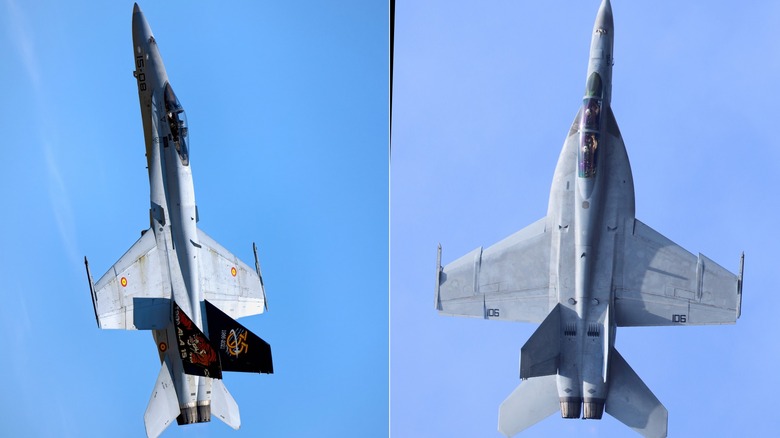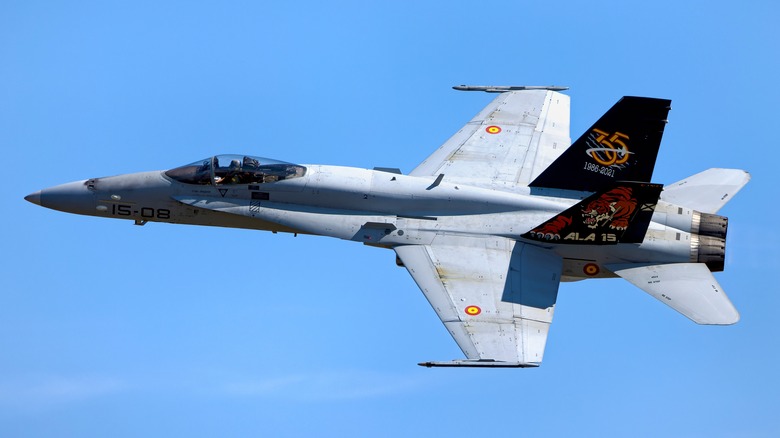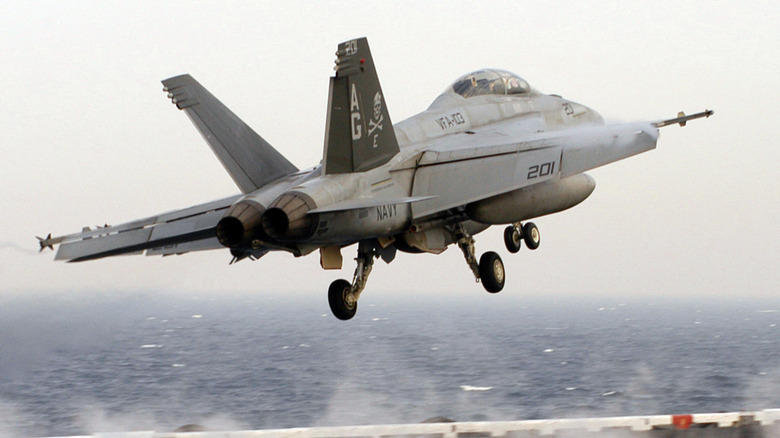What's The Difference Between The F/A-18 Hornet And Super Hornet Fighter Jets?
Whenever the United States military fields new equipment, it tends to go through various refits and upgrades over time. Instead of outright replacing the M-16 during the Vietnam War, the Army switched to the M-16A1 and, a while later, the M-16A2. It's true for everything from guns and trucks to tanks and fighter jets. When fighter jets get upgrades, it's often given significant advances in technology, weapon systems, and more.
Fighters can also be made in several variants throughout their service life, and the F/A-18 is no exception. The aircraft first entered into the inventory in 1983 for the U.S. Marine Corps, and it's remained in service ever since. The way it's managed to stay competitive more than 40 years after its introduction is thanks to the many refits it underwent over the years. These days, the US doesn't use the original F/A-18 Hornet — we fly the F/A-18 Super Hornet.
The new name wasn't given merely because the aircraft got some new software updates and a couple of flashy missiles. The name was given because the F/A-18 Super Hornet is a vastly improved version of the original, having undergone major renovations to the airframe's size and weight, its fuel consumption, weapon stations, mission flexibility, reduced maintenance, an improved radar system, more advanced missiles, and more. So, the Super Hornet is more than just a mere upgrade.
The F/A-18A/B/C/D Hornet
The F/A-18 came into being because the U.S. Navy and Marine Corps required a versatile multi-role fighter. Ideally, the fighter had to be able to engage enemies on the ground and in the air, provide close air support, aerial intelligence, surveillance, and reconnaissance (ISR), and more. The program resulted in the F/A-18 Hornet, which first flew in 1978 before finally entering the inventory in 1983.
The F/A-18 was a highly capable aircraft throughout the 1980s, and it was upgraded several times, beginning with the F-18A, which was followed by the B, C, and D. Throughout these upgrades, the aircraft remained an F-18 Hornet, and the fighter was made deadlier, safer, and a capable foil to enemy aircraft. Production of the C and D models ended in 2000, paving the way for the development of the E and F series, both of which fall under the Super Hornet designation.
Each version had a few variations to the aircraft's overall design. The A series was a single-seat fighter, while the B was a two-seater. The C was an improved version of the A's airframe, capable of carrying more advanced weapons, and the D was an improved version of the C, but it was a two-seater that was only used by the Marine Corps. While each of these variants served the military well, transitioning into the 21st century required significantly more than the A, B, C, or D series could offer. Still, despite the improvements, the legacy aircraft remain capable fighters, so a lot of countries still fly the F/A-18 Hornet in their militaries.
The F/A-18E/F Super Hornet's improvements over its predecessors
The F-18E and F models are so different that the military decided it needed to alter the aircraft's designation to "Super Hornet" to avoid confusion, though it's unofficially called "Rhino" in operational use to avoid further confusion among aircraft carrier flight deck operations. The differences between the first four series and the following two are so vast that it's almost like an entirely different aircraft. The Super Hornet incorporated lessons learned from the prior four F/A-18's in its design, including numerous advancements across the board.
The F/A-18 Super Hornet costs more and is 20% larger than its predecessors, with a 25% greater wing area. On top of that, the Super Hornet is around 7,000 lbs. heavier when empty and an additional 8,000 lbs. heavier at maximum weight. The Super Hornet can hold 33% more fuel in its internal tanks, thanks to the size increase, which extends its interdiction mission range by 41% and its endurance by 50%.
Additionally, the Super Hornet boasts an additional two weapon stations, maxing out at 11, alongside other enhancements that make it possible to conduct more mission types. Despite the numerous improvements and greater size, the Super Hornet surprisingly requires less maintenance. The aircraft is also capable of carrying more advanced weapons and in greater numbers.
So, comparing the Hornet to the Super Hornet, it's clear that the latter is more capable, albeit larger and pricier. That said, it's more than capable of remaining competitive among an ever-growing fleet of fifth-generation fighters.


